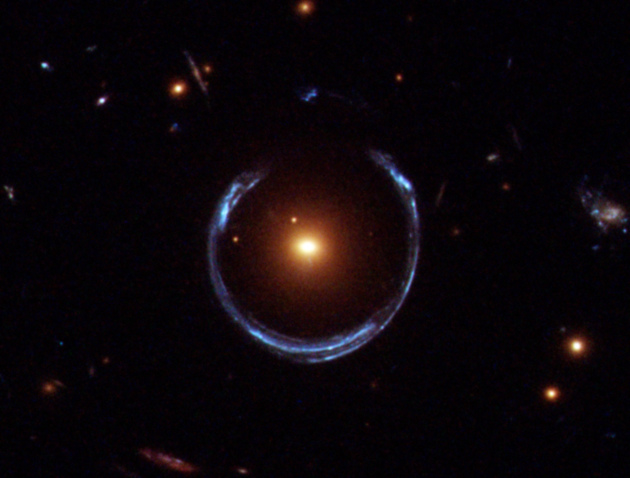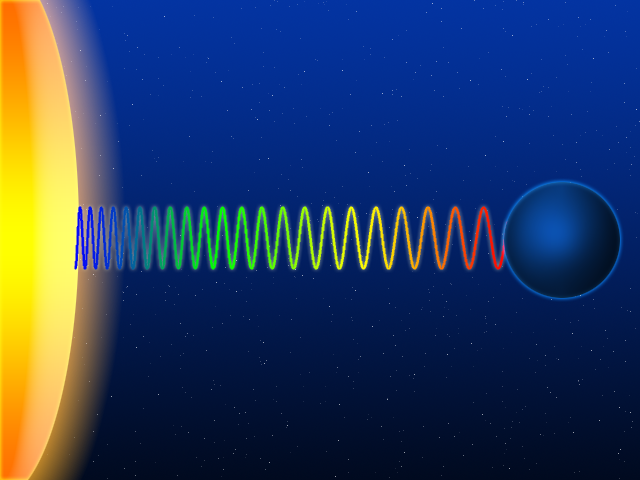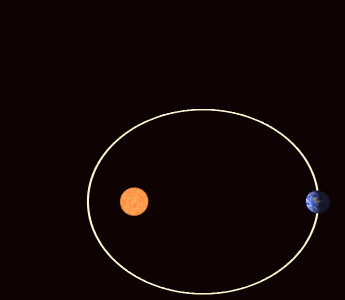Successful Predictions of General Relativity
General relativity says that the laws of special relativity are approximately correct whenever the effects of gravity are negligible. So, all of the strange consequences of special relativity—the time dilation and length contraction that occurs with objects moving at high speeds, for instance—are also predicted by general relativity. But general relativity adds some surprising new predictions that no previous theory can explain:
- Gravity bends light.

Gravitational Lensing
The ring of light in this Hubble telescope photo comes from a distant blue galaxy located behind the orange galaxy at the center of the picture. Light from the blue galaxy bends as it passes near the massive orange galaxy, so it appears from our vantage point as a circle. This lensing effect is called an “Einstein Ring.”
Credit: ESA/Hubble & NASAImage source: Wikimedia Commons, public domain.Since gravity is due to the curvature of spacetime, it affects light just as it affects things that have mass. Like all other inertially-moving objects, beams of light follow geodesics through spacetime. If the geodesics are bent, the light bends with them.
Gravitational bending of light was first observed during a solar eclipse in 1919, when astronomers measured the deflection of starlight that passed near the sun. (Normally stars aren’t visible in the daytime because the sun is too bright, but they could be seen during the eclipse.) A similar phenomenon called gravitational lensing occurs when the curvature of spacetime around a massive object (e.g. a large galaxy) focuses light like a lens.
- Time slows down near massive objects.
This effect, called gravitational time dilation, has been experimentally demonstrated using atomic clocks at differing altitudes above Earth’s surface. The clock at a lower altitude will eventually show a slightly slower time than the one at higher altitude. (In fact, the most accurate atomic clocks today are so precise that they can measure differences in the flow of time when the elevation differs by just 2 centimeters.See this news article for more details.)
To understand why this happens, we can describe the situation in terms of acceleration rather than gravity. (Remember that gravity and acceleration are physically equivalent, according to general relativity.) Imagine a spaceship accelerating to the right. At the left and right ends of the spaceship are two astronauts—we’ll call them Lefty and Righty—who synchronized their watches before the journey began. As the spaceship accelerates, their planes of simultaneity begin to pivot (in the spacetime diagram of an inertial reference frame), as we saw in our discussion of the twin paradox. Since both astronauts are accelerating to the right, their planes of simultaneity pivot upward to the right and downward to the left. Thus, Lefty’s planes of simultaneity sweep upward along Righty’s time axis, so she’ll regard his clock as running faster than hers. Righty will agree that his own clock is running faster, because his planes of simultaneity are pivoting the same way. So, both astronauts will regard Lefty’s clock—the clock at the back end of the accelerating spaceship—as running slower. Therefore, since gravity and acceleration are physically equivalent, the same thing must happen if the spaceship is at rest in a gravitational field, with its front end pointing “upward.” Lefty’s clock, which is farther “down” in the gravitational field, runs slower than a clock higher “up” in the field.John Norton gives a similar explanation with some nice illustrations here.
Without the general theory of relativity, the GPS in your car or phone wouldn’t work. Global Positioning System (GPS) navigation relies on very precise synchronization of atomic clocks on satellites orbiting the earth. Engineers have to take gravitational time dilation into account when synchronizing those clocks. GPS satellites orbit approximately 20,000 km above Earth. At that altitude, clocks run just slightly faster, by about 45 microseconds—that’s 45 millionths of a second—per day. However, the GPS satellites also undergo greater acceleration due to their orbital motion around the earth, and acceleration slows time down. (Remember the solution to the twin paradox.) Due to their acceleration, the orbiting clocks run about 7 microseconds slower than they would at rest. The net result of these two effects is that GPS satellite clocks run 45 – 7 = 38 microseconds faster per day than earth-based clocks. That’s about 1 extra second per 70 years, which doesn’t sound like much. However, GPS relies on such precise synchronization that this tiny discrepancy would cause GPS navigation systems to lose accuracy by more than 10 km per day!See this Physics Central article by Clifford M. Will for further explanation.
- Gravity stretches light.

Gravitational redshift
As light travels away from a massive star, its wavelength increases.
Credit: Vlad2i, Creative Commons CC BY-SA 3.0via Wikimedia CommonsAs light travels away from a massive object like a star or galaxy, the wavelength of the light increases and its frequency decreases. This effect, called gravitational redshift, is similar to redshift caused by the Doppler effect.
To see why gravitational redshift occurs, let’s return to the astronauts Lefty and Righty in the accelerating spaceship. Suppose Lefty shines a flashlight to the right, i.e. toward the front end of the spaceship. By the time the beam reaches Righty, the ship will be moving slightly faster (since it is accelerating). When Righty measures the wavelength and frequency of the light, his measuring tape will be shorter and his clock will be running slower than Lefty’s was when she measured the light, due to the time dilation and length contraction that occurs at higher speeds. So, from Righty’s perspective the beam has lower frequency and longer wavelength. Wavelength increases and frequency decreases (from the astronauts’ perspective) as light travels toward the front of the accelerating spaceship. Therefore, according to the equivalence principle, the same thing must happen if the spaceship is at rest with its front end “upward” in a gravitational field.
- Gravity makes waves.
When massive objects move quickly, this can cause ripples of curvature to travel through spacetime itself, like waves rolling across the surface of a pond. These waves of spacetime, called gravitational waves, were detected for the first time in 2015—nearly a century after Einstein predicted their existence. Indirect evidence for the existence of gravitational waves had been found in the 1970s by monitoring changes in the orbits of binary stars, which gradually spiral toward each other as some of their kinetic energy is converted to gravitational waves. But gravitational waves themselves had never been detected prior to 2015.
This brief video by LIGO Lab Caltech describes the first detection of gravitational waves.
Copyright: LIGO Lab Caltech: MIT. Permission to embed this video is granted by the copyright holder via YouTube’s Terms of Service.This video was uploaded to YouTube by the copyright holder, who enabled the option to embed the video in the YouTube “Embeddable Player.” According to the Terms of Service, section 6C, this constitutes an agreement to “grant each user of the Service a non-exclusive license to access your Content through the Service, and to use, reproduce, distribute, display and perform such Content as permitted through the functionality of the Service and under these Terms of Service.”The waves were detected by the Laser Interferometer Gravitational-Wave Observatory (LIGO), which is basically a high-tech version of the device Michelson and Morley had used to look for an aether wind. (To see how it works, check this out.)
In addition to these successful new predictions, Einstein’s general theory of relativity finally solved an old puzzle about the orbits of planets around the sun. Newton had explained why the planetary orbits are approximately elliptical, as mentioned in chapter 2. However, it turns out that the ellipse itself precesses (rotates), as shown in the animation below. This phenomenon, called orbital precession, was first detected with the planet mercury in 1859; later observations revealed that other planets (and also moons, comets, etc.) precess in a similar way. Orbital precession could not be adequately explained by Newton’s laws, but was explained by general relativity.
